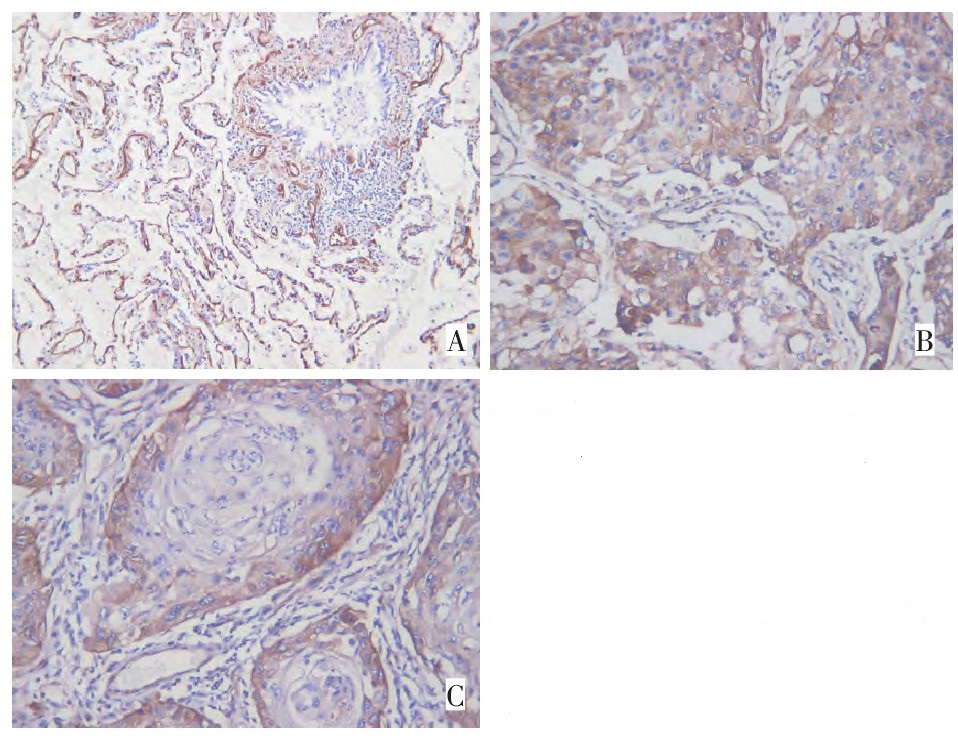Expression of Caveolin-1 and its significance in the prognosis of lung squamous cell carcinoma
-
摘要:
目的 研究Caveolin-1在人肺鳞癌中的表达, 探讨Caveolin-1的表达与人肺鳞癌临床病理特征以及预后的关系。 方法 运用免疫组织化学法检测人肺鳞癌组织中Caveolin-1、PCNA的表达, 并结合患者的临床病理特征和生存情况进行分析。 结果 Caveolin-1在人肺鳞癌中阳性率显著低于正常肺组织(P < 0.001);Caveolin-1的表达与肺鳞癌的TNM分期(P=0.018) 及淋巴结状态(P=0.006) 有关。在人肺鳞癌组织中Caveolin-1与PCNA表达呈正相关(r=0.360, P=0.018)。生存分析显示肺鳞癌中Caveolin-1阳性组的生存时间显著低于阴性组(P=0.007), 在24例淋巴结未转移组中Caveolin-1阳性组的生存时间显著低于阴性组(P=0.002)。多因素Cox分析显示Caveolin-1阳性表达、高临床分期、支气管残端有癌残留的肺鳞癌患者术后生存时间较短。 结论 Caveolin-1的表达与肺鳞癌的恶性演进呈正相关; 其可促进肺癌细胞的增殖。Caveolin-1可作为评估肺鳞癌患者的不良预后指标。 -
关键词:
- 肺鳞癌 /
- Caveolin-1 /
- 预后
Abstract:Objective This study aims to examine caveolin-1 expression in lung squamous cell carcinoma (LSCC), to investigate the relationship of caveolin-1 expression with clinicopathological features, and to estimate the prognostic value of caveolin-1. Methods Immunohistochemical staining was used to determine caveolin-1 and PCNA expression in LSCC.The correlation among caveolin-1 expression, pathological features, and clinical outcomes were investigated. Results The positive rate of caveolin-1 protein was significantly lower in LSCC than in normal lung tissues (P < 0.001).Caveolin-1 expression was statistically correlated with the TNM stage (P=0.018) and lymph node metastasis (P=0.006).Caveolin-1 expression was also positively correlated with PCNA expression in LSCC (r=0.360;P=0.018).The Kaplan–Meier survival curve showed that patients with positive caveolin-1 expression had a significantly shorter survival time compared with the patients with negative expression (P=0.007).The caveolin-1-positive group had a significantly shorter survival time in 24 patients without lymph node metastasis compared with the negative group (P=0.002).Cox multivariate analysis revealed that patients with caveolin-1 positive expression, high TNM stage, and positive surgical margin had a significantly unfavorable prognosis. Conclusion Caveolin-1 expression is positively correlated with LSSC development as well as progression, and may promote tumor cell proliferation.Caveolin-1 may be used as a poor prognosis marker of LSCC. -
Key words:
- lung squamous cell carcinoma /
- Caveolin-1 /
- prognosis
-
表 1 人肺鳞癌组织中Caveolin-1的表达与临床病理特征的关系
例 Table 1. Relationship between Caveolin-1 expression and clinicopathological features in lung squamous cell carcinoma

表 2 多因素Cox统计分析结果
Table 2. Results of Cox multivariate regression analysis

-
[1] Burgermeister E, Liscovitch M, R cken C, et al. Caveats of Caveolin-1 in cancer progression[J]. Cancer Lett, 2008, 268 (2): 187-201. doi: 10.1016/j.canlet.2008.03.055 [2] Li M, Chen H, Diao L, et al. Caveolin-1 and VEGF-C promotelymph node metastasis in the absence of intratumoral lymphangiogenesis innon-small cell lung cancer[J]. Tumori, 2010, 96 (5): 734-743. doi: 10.1177/030089161009600516 [3] Joo HJ, Oh DK, Kim YS, et al. Increased expression of Caveolin-1and microvessel density correlates with metastasis and poor prognosisin clear cell renal cell carcinoma[J]. BJU Int, 2004, 93 (3): 291-296. doi: 10.1111/j.1464-410X.2004.04604.x [4] Chen HL, Fan LF, Gao J, et al. Differential expression and functionof the Caveolin-1 gene in non-small cell lung carcinoma[J]. OncolRep, 2011, 25 (2): 359-366. [5] Witkiewicz AK, Dasgupta A, Sotgia F, et al. An absence of stromalCaveolin-1 expression predicts early tumor recurrence and poorclinical outcome in humanbreast cancers[J]. Am J Pathol, 2009, 174 (6): 2023-2034. doi: 10.2353/ajpath.2009.080873 [6] Williams TM, Lisanti MP. Caveolin-1 in oncogenic transformation, cancer, and metastasis[J]. Am J Physiol Cell Physiol, 2005, 288 (3): C494-C506. doi: 10.1152/ajpcell.00458.2004 [7] Nohata N, Hanazawa T, Kikkawa N, et al. Caveolin-1 mediatestumor cell migration and invasion and its regulation by miR-133ain head and necksquamous cell carcinoma[J]. Int J Oncol, 2011, 38 (1): 209-217. [8] Du ZM, Hu CF, Shao Q, et al. Upregulation of Caveolin-1 andCD147 expression in nasopharyngeal carcinoma enhanced tumorcell migrationand correlated with poor prognosis of the patients[J]. Int J Cancer, 2009, 125 (8): 1832-1841. doi: 10.1002/ijc.24531 [9] Ando T, Ishiguro H, Kimura M, et al. The overexpression of Caveolin-1 and caveolin-2 correlates with a poor prognosis and tumorprogression inesophageal squamous cell carcinoma[J]. Oncol Rep, 2007, 18 (3): 601-609. [10] Horiguchi A, Asano T, Asakuma J, et al. Impact of Caveolin-1 ex pression on clinicopathological parameters in renal cell carcinoma[J]. J Urol, 2004, 172 (2): 718-722. doi: 10.1097/01.ju.0000130943.23317.08 [11] Kato K, Kawashiri S, Yoshizawa K, et al. Expression form of p53and PCNA at the invasive front in oral squamous cell carcinoma: correlation withclinicopathological features and prognosis[J]. J OralPathol Med, 2011[Epub ahead of print]. [12] Cho DS, Yim H, Cho KS, et al. Impact of Caveolin-1 expressionon the prognosis of transitional cell carcinoma of the upper urinarytract[J]. J Korean Med Sci, 2008, 23 (2): 296-301. doi: 10.3346/jkms.2008.23.2.296 -




 下载:
下载:





